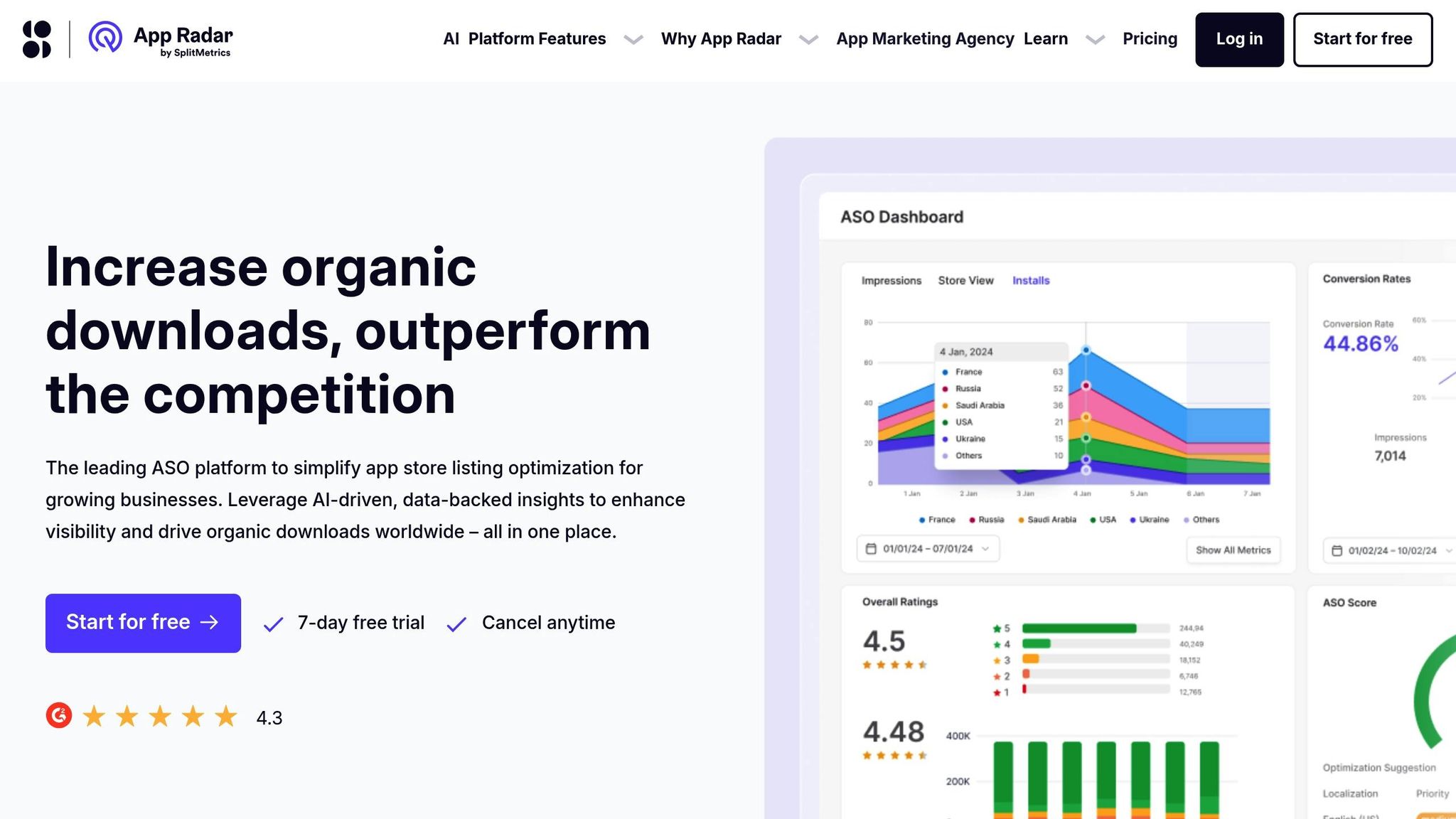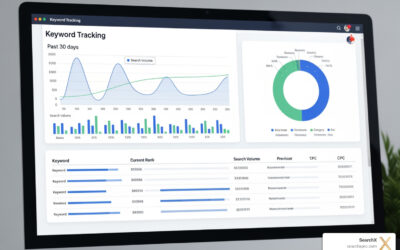If you want your banking app to stand out in crowded app stores, keywords are your best tool. Nearly 65% of app downloads come from search, and 40% of users find apps through search engines. Here’s how keywords help:
- Increase Visibility: Keywords make your app easier to find in searches.
- Attract the Right Users: Targeted terms bring in users looking for banking services.
- Stay Competitive: Optimized keywords help you outrank competitors.
Quick Tips to Get Started:
- Understand User Search Patterns:
- Banking app searches are short (1-2 words).
- Focus on features users care about: account management, transfers, bill pay, etc.
- Use Keyword Research Tools:
- Analyze Competitors:
- Study their keywords, metadata, and app store strategies.
- Prioritize Keywords:
- Focus on terms with high search volume and low competition.
- Optimize Metadata:
- Place keywords in the app title, subtitle, and description for better visibility.
Example: High-Impact Keywords for Banking Apps
- "Mobile banking app"
- "Secure fund transfer"
- "Bill payment app"
- "P2P payments"
- "FDIC-insured banking"
By using these strategies and regularly updating your keywords, you can improve your app’s visibility, attract more users, and boost downloads.
How to do app keyword research and optimization with App Radar?

Banking App User Search Patterns
Understanding how users search is key to shaping your keyword strategy. On average, searches for mobile banking apps consist of just 1.4 words, compared to the four-word average seen on search engines. Let’s dive into the features users prioritize when searching for banking solutions.
Common Banking Feature Keywords
When it comes to mobile banking, users often search for specific features:
- Account Management: Checking balances and reviewing transaction histories
- Money Movement: Transferring funds
- Digital Services: Mobile check deposits
- Payment Solutions: Bill payments and setting up automatic payments
D.J. Haskins highlights this trend:
"Consumers today turn to Google to find just about ‘the best’ anything: from restaurants to dishwasher repairmen. The more we do this, the more specific our searches become and the more numerous the words in the query."
This shift is particularly relevant as a staggering 97% of U.S. millennials now use mobile banking. These feature-focused searches often overlap with broader banking-related terms.
Banking Industry Terms
The language of banking reveals a split between formal industry jargon and everyday terms. A 2024 case study by Workshop Digital showed that during a regional bank merger, branded search traffic accounted for 76% of total conversions.
Different user segments tend to search in distinct ways:
| User Type | Search Pattern | Common Terms |
|---|---|---|
| New Users | Broad, feature-focused | "mobile banking app", "bank account management" |
| Existing Customers | Brand plus feature-specific | "[bank name] mobile deposit", "[bank name] bill pay" |
| Feature Seekers | Function-specific | "P2P payments" |
Tailoring your strategy to reflect regional and cultural differences is essential. Studies show that various ethnic groups interact with banking apps in unique ways. Combining technical terms like "FDIC-insured" with simple phrases such as "transfer funds" ensures you capture a wide range of search intents.
These insights lay the groundwork for effective keyword research and better app store optimization, which we’ll explore further in upcoming sections.
Finding the Right Keywords
Choosing the right keywords for banking apps requires a mix of specialized tools and careful analysis. To stand out in app stores, focusing on mobile-optimized keyword research is a must.
Top Keyword Research Tools
Tools like AppTweak offer valuable insights into keyword trends. With access to data on over 10 million keywords across 100+ countries, AppTweak uses its Atlas AI technology to provide features like Keyword Clusters and Keyword Relevancy Scores, making it easier to identify high-potential search terms for banking apps.
Mike Reese, a Mobile App Manager, highlights the platform’s impact:
"AppTweak’s insights into the competitive landscape are a game-changer for our strategy."
For a well-rounded approach, consider combining multiple tools:
| Tool | Best For | Key Features |
|---|---|---|
| Google Keyword Planner | Search Volume Data | Bid estimates, trend analysis |
| AppTweak | App Store Optimization | Keyword clusters, relevancy scoring |
| Semrush | Competitive Analysis | Keyword gap analysis |
Competitor Keyword Analysis
Beyond using tools, studying competitors can reveal valuable opportunities. By analyzing their strategies, you can identify areas where they excel and where they fall short, opening doors to outperform them.
Nikki Lam, VP of SEO at NP Digital, shares this perspective:
"It’s important to understand why competitors are outperforming you, how they’re meeting user needs better, and on the flip side, where they’re weak and leaving you an opening to get ahead."
For instance, Binance achieved notable success in 2023 by focusing on localized strategies and metadata optimization. Their approach included:
- Tracking competitor metadata updates
- Analyzing Apple Search Ads campaigns
- Spotting underserved keyword opportunities
- Tailoring content for regional audiences
Keyword Priority Matrix
To streamline your App Store Optimization (ASO) efforts, prioritize keywords based on their search volume, competition level, and strategic value:
| Priority Level | Search Volume | Competition | Action |
|---|---|---|---|
| High | >10,000/month | Low–Medium | Immediate implementation |
| Medium | 1,000–10,000/month | Medium | Strategic planning |
| Low | <1,000/month | High | Long-term consideration |
Focus on intent-driven keywords that match specific banking services. For example, 94% of smartphone users search for location-based information. Including local keywords for nearby banking services can significantly improve performance, as search engine leads have a close rate of 14.6%.
Tools like SearchX can help pinpoint high-value keywords by analyzing competitive gaps and user intent patterns. Their approach blends technical insights with actionable strategies tailored specifically for banking apps.
To stay ahead, regularly review and update your keyword strategy to match evolving user search behaviors.
sbb-itb-880d5b6
Using Keywords in App Store Listings
Once you’ve identified the right keywords, the next step is weaving them effectively into your app store listing. Each part of the metadata plays a crucial role in boosting your app’s visibility and encouraging downloads.
App Title and Subtitle Keywords
The app title holds the most weight in app store algorithms. On iOS, you get 30 characters for the title and another 30 for the subtitle, while Google Play offers a more generous 50 characters for the title.
| Metadata Field | Character Limit | Example |
|---|---|---|
| App Title | 30 (iOS) / 50 (Google) | "BankPro: Mobile Banking App" |
| Subtitle (iOS) | 30 | "Secure Payments & Transfers" |
Gabriel Kuriata, Content Manager at SplitMetrics, highlights the importance of this:
"App Store keywords reflect user intent, and choosing the right ones to rank for is essential in optimizing our organic visibility on the App Store."
To make the most of these fields, place your high-value keywords at the very beginning of the title and subtitle. For example, in the case of a banking app, prioritize terms that highlight key features users are actively searching for.
After fine-tuning your title and subtitle, focus on leveraging the dedicated keyword field to further enhance your app’s discoverability.
Keyword Field Setup
The iOS keyword field gives you 100 characters to target search terms. Optimizing this field can significantly strengthen your App Store Optimization (ASO) strategy, especially for niche terms related to banking.
Here’s how to make the most of it:
- Maximize Character Usage
- Skip spaces and use commas as separators.
- Stick to singular forms of words.
- Avoid repeating your brand name unnecessarily.
- Focus on Specific Banking Terms
With 70% of app downloads originating from search, selecting precise keywords is essential for standing out.
Description Keywords
Your app description is another opportunity to incorporate keywords while keeping the text engaging and easy to read. Since search-driven downloads are a major driver of app installs, relevance and readability go hand in hand.
To structure your description effectively:
- Open with a brief introduction that highlights your app’s core features.
- Use headers to organize key banking functionalities.
- Include bullet points to detail specific services, ensuring keywords are naturally integrated.
Apple Ads supports this approach, stating:
"By choosing relevant and popular keywords, you can reach these customers at the moment they’re searching for apps."
Measuring Keyword Success
Tracking keyword performance is crucial for fine-tuning your ASO strategy and increasing visibility, especially since 65% of app downloads start with a search.
Keyword Rank Tracking
Keeping an eye on keyword rankings helps you identify shifts and spot opportunities. Here are a few key metrics to focus on:
| Metric | What to Track | Why It Matters |
|---|---|---|
| Visibility Score | Overall keyword performance | Shows how well your keywords perform over time. |
| Category Ranking | Position in Finance/Banking | Highlights your competitive position in the category. |
| Search Rankings | Individual keyword positions | Identifies which terms are driving app discovery. |
These metrics provide a foundation for understanding how users interact with your app through downloads and engagement.
Download and Usage Data
To connect keyword performance with user behavior, track the following:
- Activation Rate: Measure the percentage of users who actively use banking features after downloading.
- Daily Active Users (DAU): See how keywords influence daily app engagement.
- Retention Rate: Identify which keywords bring in users who stick around long-term.
- Conversion Rate: Analyze how specific keywords drive key banking actions within the app.
Fun fact: even a 5% increase in retention can lead to over 25% more revenue. With this in mind, staying on top of app store updates becomes essential to maintaining keyword success.
App Store Updates
Adapting to changes in app store algorithms ensures your keywords continue to perform well. Here’s how you can stay ahead:
- Regular Performance Reviews: Use tools like AppTweak to analyze the impact of keywords on organic downloads before and after updates.
- Metadata Optimization: Experiment with new app titles and descriptions on Google Play to improve conversion rates.
- Search Ads Integration: Leverage insights from Apple Search Ads to identify high-performing banking-related terms and incorporate them into your app’s metadata.
After implementing updates, make sure to track these key metrics:
- Views-to-installs ratio
- Reviews and ratings
- Search visibility scores
These steps will help ensure your ASO strategy remains effective and aligned with user behavior trends.
Conclusion: Next Steps for Banking App Keywords
Optimizing keywords for banking apps demands a flexible, data-driven approach. With app search playing a major role in driving downloads, these strategies refine earlier keyword research and app store optimization (ASO) efforts to stay ahead of the curve.
To stay competitive, consider these tried-and-true strategies:
| Strategy | Implementation | Expected Impact |
|---|---|---|
| Regular Monitoring | Review keyword performance every 3-6 weeks | Boosts visibility and ranking |
| AI Integration | Use AI tools for content and keyword research | Improves metadata relevance |
| Voice Search | Focus on conversational, long-tail keywords | Expands user reach |
| Custom Store Listings | Tailor listings for specific user intent | Increases conversion rates |
Industry professionals stress the importance of focused optimization:
"Something that I learned early on is to stick to a manageable amount of keywords, instead of aiming for too many. Additionally, don’t forget to iterate as much as possible; analyze other competitor’s metadata, not only texts but also copies in visuals. You can even find new keywords in reviews from users. Learn to work with AI tools; if you’re not doing so already, you’re missing out."
- Guillermo Borrero, ASO Specialist
With 71.5% of Americans now using AI tools for searches, the possibilities for banking apps to embrace semantic search and personalization are growing. Focus on crafting metadata that naturally incorporates keywords while clearly highlighting your app’s unique benefits.
Keyword optimization doesn’t just improve rankings – it also boosts user engagement. To make the most of these insights, keep analyzing user behavior and adjust your strategy as needed:
- Build a strong presence across multiple platforms
- Engage with financial communities
- Optimize for local search to capture regional opportunities
- Use AI tools, but always pair them with human oversight
FAQs
How can I find the best keywords to boost my banking app’s visibility in app stores?
To make your banking app stand out in app stores, start by pinpointing keywords your audience is likely to use when searching. Tools like Google Keyword Planner or App Store Optimization (ASO) platforms can help you find relevant terms, such as mobile banking, secure banking app, or online banking. Aim for keywords with a good balance – high search volume but low competition – to improve your app’s chances of being discovered.
After selecting the right keywords, weave them naturally into your app’s title, description, and metadata. This not only boosts your app’s ranking but also aligns with what users are looking for. Keep an eye on your app’s performance metrics and refine your keyword strategy regularly to stay ahead in search results.
What are the best strategies to help my banking app rank higher in search results?
To help your banking app climb higher in search rankings, focus on these core strategies:
- Keyword Research: Pinpoint keywords that are relevant to your app, have a decent search volume, and face minimal competition. Incorporate these terms thoughtfully into your app’s title, description, and metadata to improve its discoverability.
- App Store Optimization (ASO): Fine-tune your app’s store page by boosting ratings, gathering reviews, and maintaining strong user retention. Encourage happy users to share positive feedback while addressing negative reviews quickly and professionally.
- Backlinks: Strengthen your app’s authority by partnering with reputable financial websites and blogs to build quality backlinks. This not only enhances credibility but also drives organic traffic to your app.
By sticking to these strategies, you can improve your app’s visibility and gain an edge over competitors in search rankings.
How can I optimize my app store listing to attract and retain users for a banking app?
To make your banking app stand out in the app store and draw in more users, start with smart keyword research and thoughtful placement. Pinpoint the terms your target audience is searching for, and use tools to study trends and competitors. Once you have a solid list, weave these keywords into your app’s title, description, and metadata to boost visibility.
But it’s not just about keywords – your app listing needs to look great, too. Include high-quality screenshots and videos that highlight your app’s standout features. Pair these visuals with short, engaging descriptions that clearly explain the app’s benefits. Regular updates to your listing, informed by user feedback and seasonal trends, can also help keep your app fresh and relevant. These steps won’t just make your app easier to find – they’ll also encourage users to stick around by delivering a polished, user-focused experience.




